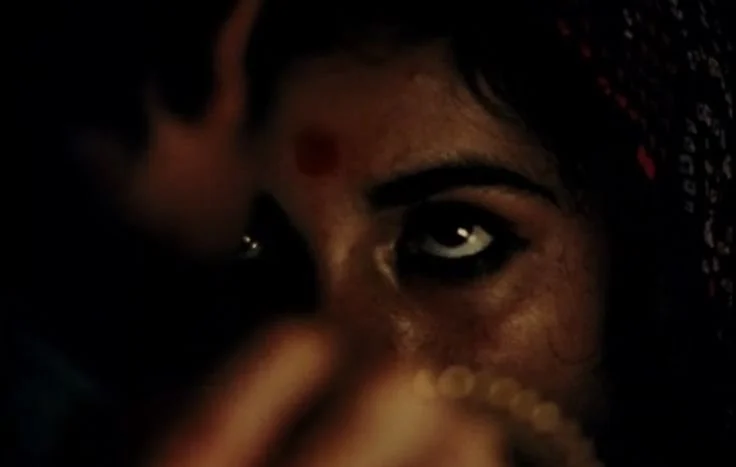DUVIDHA: Beyond The Veil
Words by Evie Leese
Still from Duhvida
Unfolding in subdued ecstasy, Mani Kaul’s Duvidha (1973) retells a Rajasthani folk-tale with the hushed control of a whisper, like a secret faintly alive in the collective ancestral imagination, recalling the clandestine breath through which ritual and magic-like rubble remains.
The story opens with a young couple’s wedding day and the groom’s nearing departure. In the absence of any opulent marital celebration to start the action, Kaul chooses to foreground intimate glances and undisclosed displays of emotion via close-ups. This is coupled with his choice to forego cinematic convention in favour of cultivating a mythic temporal logic conveyed by sequences of motion interlaced with still images. As the groom informs his bride that he will soon be leaving for five years to earn a fortune in a distant town, a ghost inhabiting a banyan tree looks upon the bride and becomes enraptured by her beauty. When the husband leaves, seeing it unnecessary to consummate his marriage before he does so, the ghost grasps this opportunity to present himself to the bride as the man she married, and metamorphoses into her husband’s outward appearance. With an unanticipated revelation of integrity and, more so, of love, the ghost unveils his deceit to the bride and in response to his confession, she embraces him as her husband and consummates the ‘marriage,’ thus centralising a muted but nonetheless radical defiance of the persisting patriarchal order as the titular ‘dilemma’ of the tale.
Still from Duvidha
Spoken dialogue is sparse, which invites the audience to instead participate in an unveiling of the bride in order to make deductions; extracting sentiment from her gaze, which at pivotal moments meets the camera lens in resolved confrontation where it is other times obscured by a shroud like a gauze - her head bowed, eyes averted, or visage crowded by ornamental regalia. In vibrant hues, her many face-framing headscarves and veils distil her rendering of emotion, functioning as intricate set designs allowing for a private disclosure of feeling within the bounds of domesticity. The pertinence of the film opening with the bride’s frank return of the eyes of the spectator then becomes apparent: this is a film in which ghost and wife find affinity through their parallel atrophied existence, their union becoming the site upon which they each re-establish actuality through a reversal which observes man swept into alterity and witnesses the rediscovering of identity founded on faith in one another’s existence.
Still from Duvidha
Edenic reminiscence in the early moments of the film, when the bride eats fruit from a tree against her husband’s wishes, signals a flight from pre-existing order and a fall from paradisiacal grace which parallels this reversal of power dynamics. Lingering over typically non-eroticised body parts like her open henna-stained palms and feet placed in velvet, the eye of the camera issues a sensuality through tactility which reiterates the earthen and material grounding of the film, thereby centralising a dual aspect to the film as the realm of the jinn (malefic, troublesome spirits) collides with that of the bride. This sensuous dimension involves the reality of what is only implied, known to be certain only through held shots which carry the implication of the unseen other, and this subtlety elevates sensuality by confirming an interdependence between the known and the hidden, translating to an interdependence between the bride and the ghost, the body and the spirit. Glances, then, become meaningful through the viewer’s witnessing, which allows for the imagination to follow. An itch of erotic prurience is thus kept alive in which viewers play the role of complicit voyeurs – this itch is made all the more prominent because it is a figment of the voyeur’s imaginative, speculative and fantastical faculties.
Still from Duvidha
Kaul’s first colour picture leans into this pervasive unworldly and sensorial feel through heavy portions of silence as the bride and ghost, in her husband’s image, live quietly in the mise-en-abyme of their domestic space – the arches and pillars dividing their home into geometric quarters function as a haunting cinematic stage whereupon thresholds between a lower and higher plane, and between the two lovers, proliferate. With this arrangement distance is woven into their affair, rendering the climactic moment of their embrace one of ecstatic rapture, sealed through their eyes meeting. In the bride’s active looking, her decision to engage with the ghost is a weighted one, as her desire is followed by its completion. Her eyes alone make this apparent; her resolve is felt through her irises as her face lifts from the ground before falling again in semblance of the motion of prayer, as though bowing to the incorporeal forces which brought her love in a time that would otherwise be marked by abandon.
This reverberation of love is offered up to the audience as an unspoken tie between the bride and ghost, allowing for the renouncing of strong narrative elements in favour of stillness and understated gestures; an expression that they each exist as mirrors unto their own faith in the verity of their passionate exchange. Kaul’s cinematic concealment therefore solicits a seeking-out of meaning, inviting viewers to look beyond what is masked. This becomes markedly relevant if a consideration of the nature of jinn is taken – its J-N-N root means “to cover, veil, conceal,” bringing the bride and the ghost closer in likeness, as though borne from the same tap-root of the banyan tree. Living a mutually veiled existence, therefore, the mirrored echo-chamber of reciprocal love could be thought of as a mirror towards a greater Love, existing in the earth’s veiled contours, in an unseen realm. Duvidha breathes this secret into an eclipsed apophatic reality, imploring us to turn our eye beyond the veil.
Still from Duvidha





